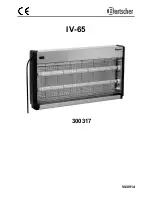
9. Safety advice
• Do not use in the bathroom.
• Keep the appliance out of the reach of children.
• Use the appliance for domestic use only, as described in this manual and following the instructions carefully.
• Do not use this appliance at the same time as any other appliance transmitting electrical current into the body.
• Do not use the appliance while operating machinery.
• Do not immerse in water or any other liquid. Do not use above or close to a bath, wash basin or other water
containers.
• Unplug the appliance after use or before cleaning it.
• Always ensure the voltage being used corresponds to the voltage on the appliance.
• Stop using the appliance immediately if the power cord becomes damaged. If the power cable is
damaged, it should be replaced by a special assembly available from the manufacturer. Return the
appliance to the Conair Service Centre. Information on how this should be done is provided in the
section headed «UK After Sales Service: What to do?».
• Return the appliance to the manufacturer for inspections, adjustments or electrical or mechanical repairs. The
user must never carry out any repairs.
• This appliance meets the requirements of directives 89/336/EEC (electromagnetic compatibility) and
73/23/EEC (safety of electric domestic appliances), amended by directive 93/68/EEC (CE marking).
• When the battery has worn out, it should be disposed of in a recycling centre in order to safeguard the
environment. If the battery leaks, avoid touching it and dispose of it at a recycling centre.
10. Ni-MH battery
This appliance contains a Nickel-Metal-Hydride battery.
To help protect our environment, the Nickel-Metal-Hydride battery should be removed for safe disposal at the
end of its life.
To remove the battery for disposal or recycling, please follow the procedure below:
1. First switch off the appliance and unplug it. Unscrew the 4 screws located at the back of the body.
2. Open the appliance, disconnect the battey, then remove it.
3. For environmental reasons, do not discard the battery with your regular refuse. Contact your
local authorities for more details on recycling and safe disposal facilities in your area.
13
IB 8320 E 6/03/06 10:42 Page 13














































